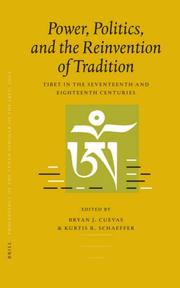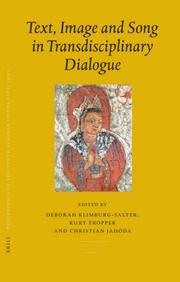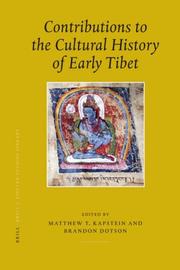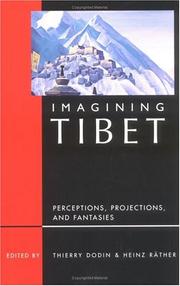| Listing 1 - 10 of 31 | << page >> |
Sort by
|

ISBN: 1281400440 9786611400446 9047410823 9789047410829 9004153519 9789004153516 Year: 2006 Publisher: Leiden Boston Brill
Abstract | Keywords | Export | Availability | Bookmark
 Loading...
Loading...Choose an application
- Reference Manager
- EndNote
- RefWorks (Direct export to RefWorks)
Tibet Autonomous Region (China) --- Tibetan Autonomous Region (China) --- Hsi-tsang tzu chih chʻü (China) --- Xizang Zizhiqu (China) --- 西藏自治区 (China) --- Hsi-tsang tzu chih chʻü jen min cheng fu (China) --- Xizang Zizhiqu ren min zheng fu (China) --- TAR (China) --- Xizang Autonomous Region (China) --- Bod Raṅ-skyoṅ-ljoṅs (China) --- Bod (China) --- Sitsang (China) --- Tibet (China) --- Thibet (China) --- Tibet-Chamdo (China) --- Tübüt (China) --- Xizang (China) --- Tibet --- History --- Тибет (China) --- Tu̇vd (China) --- Tȯvȯd (China) --- 西藏 (China)

ISSN: 15686183 ISBN: 1281917044 9786611917043 9047411684 9789047411680 9789004155497 900415549X Year: 2007 Volume: v. 10/7 Publisher: Leiden Boston Brill
Abstract | Keywords | Export | Availability | Bookmark
 Loading...
Loading...Choose an application
- Reference Manager
- EndNote
- RefWorks (Direct export to RefWorks)
The papers in this volume all result from field work in the Indian Himalayas and the TAR conducted by the Interdisciplinary Research Unit, Austrian Science Fund. While the research goals were established within the framework of transdisciplinary research, each scholar approaches scientific problems according to the methodologies associated with their respective disciplines: philology, philosophy, history, art history, linguistics, and anthropology. In the contribution published here, Steinkellner, Klimburg-Salter, Widorn, and Jahoda explicate the structure, methods, and advantages of transdisciplinary research. Lasic and Tauscher analyse two different philosophical questions on the basis of manuscripts from Tabo (Spiti) and Gondhla (Lahaul). Pasang Wangdu, Tropper and Ponweiser each examine a Buddhist monument from a different perspective: Keru (TAR), Wanla (Ladakh), and Tabo. Papa-Kalantari and Hein discuss respectively an iconographic problem and oral traditions from Spiti and upper Kinnaur.
Himalaya Mountains Region --- Tibet (China) --- Tibetan Autonomous Region (China) --- Hsi-tsang tzu chih chʻü (China) --- Xizang Zizhiqu (China) --- 西藏自治区 (China) --- Hsi-tsang tzu chih chʻü jen min cheng fu (China) --- Xizang Zizhiqu ren min zheng fu (China) --- TAR (China) --- Xizang Autonomous Region (China) --- Bod Raṅ-skyoṅ-ljoṅs (China) --- Bod (China) --- Sitsang (China) --- Thibet (China) --- Tibet-Chamdo (China) --- Tübüt (China) --- Xizang (China) --- Tibet --- Civilization --- Tibet Autonomous Region (China) --- Тибет (China) --- Tu̇vd (China) --- Tȯvȯd (China) --- 西藏 (China)

ISSN: 15686183 ISBN: 1282397532 9786612397530 9047421191 9789047421191 9789004160644 9004160647 Year: 2007 Volume: 14 Publisher: Leiden Boston Brill
Abstract | Keywords | Export | Availability | Bookmark
 Loading...
Loading...Choose an application
- Reference Manager
- EndNote
- RefWorks (Direct export to RefWorks)
The study of the rise and institutions of the Tibetan empire of the seventh to ninth centuries, and of the continuing development of Tibetan civilization during the obscure period that followed, have aroused growing interest among scholars of Inner Asia in recent decades. The six contributions presented here represent refinements in substance and method characterizing current work in this area. A chapter by Brandon Dotson provides a new perspective on law and divination under the empire, while the post-imperial international relations of the Tsong kha kingdom are analyzed by Bianca Horlemann. In “The History of the Cycle of Birth and Death”, Yoshiro Imaeda’s investigation of a Dunhuang narrative appears in a revised edition, in English for the first time. The problem of oral transmission in relation to the Tibetan Dunhuang texts is then taken up in the contribution of Sam van Schaik. In the final section, Matthew Kapstein and Carmen Meinert consider aspects of Chinese Buddhism in their relation to religious developments in Tibet.
Tibet (China) --- Tibetan Autonomous Region (China) --- Hsi-tsang tzu chih chʻü (China) --- Xizang Zizhiqu (China) --- 西藏自治区 (China) --- Hsi-tsang tzu chih chʻü jen min cheng fu (China) --- Xizang Zizhiqu ren min zheng fu (China) --- TAR (China) --- Xizang Autonomous Region (China) --- Bod Raṅ-skyoṅ-ljoṅs (China) --- Bod (China) --- Sitsang (China) --- Thibet (China) --- Tibet-Chamdo (China) --- Tübüt (China) --- Xizang (China) --- Tibet --- Civilization. --- History. --- Tibet Autonomous Region (China) --- History --- Civilization --- Tibet Autonomous Region (China) - History --- Tibet Autonomous Region (China) - Civilization
Book
ISBN: 9888268198 9888268171 9789888268177 9780824840082 9780824839512 9789888208111 988820811X 9789888268191 Year: 2014 Publisher: Hong Kong Hong Kong University Press :Honolulu, Hawai'i :For distribution outside Asia, University of Hawai'i Press
Abstract | Keywords | Export | Availability | Bookmark
 Loading...
Loading...Choose an application
- Reference Manager
- EndNote
- RefWorks (Direct export to RefWorks)
Tsering Woeser and Wang Lixiong are widely regarded as the most eloquent, insightful writers on contemporary Tibet. Their reportage on the economic exploitation, environmental degradation, cultural destruction and political subjugation that plague the increasingly Han Chinese-dominated Tibet Autonomous Region (TAR) is as powerful as it is profound, ardent and analytical in equal measure, and not in the least bit ideological. Voices from Tibet is a collection of essays and reportage in translation that captures the many facets of an unprecedented sea change wreaked by a rising China upon a scar
Tibet Autonomous Region (China) --- Tibetan Autonomous Region (China) --- Hsi-tsang tzu chih chʻü (China) --- Xizang Zizhiqu (China) --- 西藏自治区 (China) --- Hsi-tsang tzu chih chʻü jen min cheng fu (China) --- Xizang Zizhiqu ren min zheng fu (China) --- TAR (China) --- Xizang Autonomous Region (China) --- Bod Raṅ-skyoṅ-ljoṅs (China) --- Bod (China) --- Sitsang (China) --- Tibet (China) --- Thibet (China) --- Tibet-Chamdo (China) --- Tübüt (China) --- Xizang (China) --- Tibet --- Civilization --- Politics and government --- Тибет (China) --- Tu̇vd (China) --- Tȯvȯd (China) --- 西藏 (China)

ISBN: 0861711912 9780861711918 Year: 2001 Publisher: Boston : Wisdom Publications,
Abstract | Keywords | Export | Availability | Bookmark
 Loading...
Loading...Choose an application
- Reference Manager
- EndNote
- RefWorks (Direct export to RefWorks)
"Scarcely has a region captured popular imagination as has Tibet. In the past century, the Western view of Tibet evolved from backward shamanistic theocracy, to exotic Shangri-la promising immortality, to an enlightened society now ravaged by outside aggression. Where did such ideas come from and why did they change?" "Imagining Tibet represents the first comprehensive attempt to explore such portrayals of Tibet in their aesthetic, intellectual, and political dimensions. It traces the earliest roots of these images in the writings of explorers and missionaries, progressing through the depictions employed by Theosophists and scholars, up to the contemporary views of political activists and Buddhist practitioners. Book jacket."--Jacket.
Tibet Autonomous Region (China) --- Région autonome du Tibet (Chine) --- Tibet (China) --- S24/0200 --- Tibet--General works --- Région autonome du Tibet (Chine) --- Tibetan Autonomous Region (China) --- Hsi-tsang tzu chih chʻü (China) --- Xizang Zizhiqu (China) --- 西藏自治区 (China) --- Hsi-tsang tzu chih chʻü jen min cheng fu (China) --- Xizang Zizhiqu ren min zheng fu (China) --- TAR --- Xizang Autonomous Region (China) --- Bod Raṅ-skyoṅ-ljoṅs (China) --- Bod (China) --- Sitsang (China) --- Thibet (China) --- Tibet-Chamdo (China) --- Tübüt (China) --- Xizang (China) --- Tibet --- TAR (China) --- Тибет (China) --- Tu̇vd (China) --- Tȯvȯd (China) --- 西藏 (China)
Book
ISBN: 0571083943 Year: 1971 Publisher: London Faber and Faber
Abstract | Keywords | Export | Availability | Bookmark
 Loading...
Loading...Choose an application
- Reference Manager
- EndNote
- RefWorks (Direct export to RefWorks)
Tibet Autonomous Region (China) --- Tibet Autonomous Region (China). --- Tibetan Autonomous Region (China) --- Hsi-tsang tzu chih chʻü (China) --- Xizang Zizhiqu (China) --- 西藏自治区 (China) --- Hsi-tsang tzu chih chʻü jen min cheng fu (China) --- Xizang Zizhiqu ren min zheng fu (China) --- TAR --- Xizang Autonomous Region (China) --- Bod Raṅ-skyoṅ-ljoṅs (China) --- Bod (China) --- Sitsang (China) --- Tibet (China) --- Thibet (China) --- Tibet-Chamdo (China) --- Tübüt (China) --- Xizang (China) --- Tibet --- 992.1 Tibet --- TAR (China) --- Тибет (China) --- Tu̇vd (China) --- Tȯvȯd (China) --- 西藏 (China)
Book
ISBN: 9463728716 9048544904 9789463728713 Year: 2019 Publisher: Amsterdam University Press
Abstract | Keywords | Export | Availability | Bookmark
 Loading...
Loading...Choose an application
- Reference Manager
- EndNote
- RefWorks (Direct export to RefWorks)
Frontier Tibet: Patterns of Change in the Sino-Tibetan Borderlands addresses a historical sequence that sealed the future of the Sino-Tibetan borderlands. It considers how starting in the late nineteenth century imperial formations and emerging nation-states developed competing schemes of integration and debated about where the border between China and Tibet should be. It also ponders the ways in which this border is internalised today, creating within the People's Republic of China a space that retains some characteristics of a historical frontier. The region of eastern Tibet called Kham, the focus of this volume, is a productive lens through which processes of place-making and frontier dynamics can be analysed. Using historical records and ethnography, the authors challenge purely externalist approaches to convey a sense of Kham's own centrality and the agency of the actors involved. They contribute to a history from below that is relevant to the history of China and Tibet, and of comparative value for borderland studies.
China --- Tibet --- Ethnic studies --- Human geography --- Borderlands --- Tibet Autonomous Region (China) --- History. --- Boundaries. --- Border-lands --- Border regions --- Frontiers --- Boundaries --- Tibetan Autonomous Region (China) --- Hsi-tsang tzu chih chʻü (China) --- Xizang Zizhiqu (China) --- 西藏自治区 (China) --- Hsi-tsang tzu chih chʻü jen min cheng fu (China) --- Xizang Zizhiqu ren min zheng fu (China) --- TAR --- Xizang Autonomous Region (China) --- Bod Raṅ-skyoṅ-ljoṅs (China) --- Bod (China) --- Sitsang (China) --- Tibet (China) --- Thibet (China) --- Tibet-Chamdo (China) --- Tübüt (China) --- Xizang (China) --- TAR (China) --- Politics. --- Sovereignty. --- Territory. --- Tibet, China, borderland, Identity. --- Тибет (China) --- Tu̇vd (China) --- Tȯvȯd (China) --- 西藏 (China)

ISBN: 1280471395 0195353137 0585294917 9780585294919 9786610471393 6610471398 0195120078 9780195120073 0197738753 Year: 1999 Publisher: New York Oxford University Press
Abstract | Keywords | Export | Availability | Bookmark
 Loading...
Loading...Choose an application
- Reference Manager
- EndNote
- RefWorks (Direct export to RefWorks)
The Tibetan district of Tsari with its sacred snow-covered peak of Pure Crystal Mountain has long been a place of symbolic and ritual significance for Tibetan peoples. In this book, Toni Huber provides the first thorough study of a major Tibetan Buddhist pilgrimage center and cult mountain, and explores the esoteric and popular traditions of ritual there. The main focus is on the period of the 1940's and '50's, just prior to the 1959 Lhasa uprising and subsequent Tibetan diaspora into South Asia. Huber's work thus documents Tibetan life patterns and cultural traditions which have largely disappeared
Buddhism --- Mountain worship --- Mountains --- Nature worship --- Buddha and Buddhism --- Lamaism --- Ris-med (Lamaism) --- Religions --- Customs and practices. --- Religious aspects --- Tibet Autonomous Region (China) --- Tibetan Autonomous Region (China) --- Hsi-tsang tzu chih chʻü (China) --- Xizang Zizhiqu (China) --- 西藏自治区 (China) --- Hsi-tsang tzu chih chʻü jen min cheng fu (China) --- Xizang Zizhiqu ren min zheng fu (China) --- TAR (China) --- Xizang Autonomous Region (China) --- Bod Raṅ-skyoṅ-ljoṅs (China) --- Bod (China) --- Sitsang (China) --- Tibet (China) --- Thibet (China) --- Tibet-Chamdo (China) --- Tübüt (China) --- Xizang (China) --- Tibet --- Religious life and customs. --- Тибет (China) --- Tu̇vd (China) --- Tȯvȯd (China) --- 西藏 (China)
Book
ISBN: 1299448623 0820345733 9780820345734 9780820338668 0820338664 9780820345123 0820345121 9781299448629 Year: 2013 Publisher: Athens, GA
Abstract | Keywords | Export | Availability | Bookmark
 Loading...
Loading...Choose an application
- Reference Manager
- EndNote
- RefWorks (Direct export to RefWorks)
Working at the intersections of cultural anthropology, human geography, and material culture, Tina Harris explores the social and economic transformations taking place along one trade route that winds its way across China, Nepal, Tibet, and India. How might we make connections between seemingly mundane daily life and more abstract levels of global change? Geographical Diversions focuses on two generations of traders who exchange goods such as sheep wool, pang gdan aprons, and more recently, household appliances. Exploring how traders ""make places,"" Harris examines the creation of geographies
Human geography --- Sheepherding --- Commerce --- Ethnology --- Anthropo-geography --- Anthropogeography --- Geographical distribution of humans --- Social geography --- Anthropology --- Geography --- Human ecology --- Sheep herding --- Herding --- Trade --- Economics --- Business --- Transportation --- Economic aspects --- Tibet Autonomous Region (China) --- Tibetan Autonomous Region (China) --- Hsi-tsang tzu chih chʻü (China) --- Xizang Zizhiqu (China) --- 西藏自治区 (China) --- Hsi-tsang tzu chih chʻü jen min cheng fu (China) --- Xizang Zizhiqu ren min zheng fu (China) --- TAR (China) --- Xizang Autonomous Region (China) --- Bod Raṅ-skyoṅ-ljoṅs (China) --- Bod (China) --- Sitsang (China) --- Tibet (China) --- Thibet (China) --- Tibet-Chamdo (China) --- Tübüt (China) --- Xizang (China) --- Tibet --- Economic conditions. --- Boundaries. --- Traffic (Commerce) --- Merchants --- Тибет (China) --- Tu̇vd (China) --- Tȯvȯd (China) --- 西藏 (China)

ISSN: 15686183 ISBN: 1281917516 9786611917517 9047428218 9789047428213 9004155201 9789004155206 Year: 2007 Volume: 10/8 Publisher: Leiden Boston Brill
Abstract | Keywords | Export | Availability | Bookmark
 Loading...
Loading...Choose an application
- Reference Manager
- EndNote
- RefWorks (Direct export to RefWorks)
Recent archaeological discoveries and scientific research especially focussed on western Tibet and the western Himalayas have resulted in a remarkable redefinition of the historical and cultural processes of the entire Indo-Tibetan civilisation. The present volume reflects these sometimes startling new insights for the first time, covering the wide time range from the Zhang zhung period up to the 20th century, spanning secular, religious and economic history, as well as art and archaeology.
Cultuurgeschiedenis. --- Art, Tibetan --- Buddhist art --- Manuscripts, Tibetan --- Tibetan manuscripts --- Art, Buddhist --- Art, Lamaist --- Art --- Buddhism and art --- Tibetan art --- History --- Tibet. --- Tibet (China) --- Tibetan Autonomous Region (China) --- Hsi-tsang tzu chih chʻü (China) --- Xizang Zizhiqu (China) --- 西藏自治区 (China) --- Hsi-tsang tzu chih chʻü jen min cheng fu (China) --- Xizang Zizhiqu ren min zheng fu (China) --- TAR (China) --- Xizang Autonomous Region (China) --- Bod Raṅ-skyoṅ-ljoṅs (China) --- Bod (China) --- Sitsang (China) --- Thibet (China) --- Tibet-Chamdo (China) --- Tübüt (China) --- Xizang (China) --- Tibet --- Civilization --- Tibet Autonomous Region (China) --- Тибет (China) --- Tu̇vd (China) --- Tȯvȯd (China) --- 西藏 (China)
| Listing 1 - 10 of 31 | << page >> |
Sort by
|

 Search
Search Feedback
Feedback About UniCat
About UniCat  Help
Help News
News